Stuffing is one of my favorite Thanksgiving side dishes, and I like to think this stuffing recipe with chestnuts brings a special addition to the holiday table. Classic and simple, and a wonderful make ahead, let’s just say this will be one more task you can check off your holiday to-do list.
If you are interested in more chestnut recipes, we have a delicious recipe for Cream of Chestnut Soup, too. But don’t stop there. Get to cooking throughout November with plenty of Thanksgiving Veggie Sides and Friendsgiving Food Ideas.

Ingredients
Whether you call it chestnut dressing or stuffing, the ingredients for this side dish remain the same. I provide plenty of tips when it comes to bread and chestnuts, too. We will need:
- Bread: Go for white bread, sourdough bread, Italian bread, or cornbread, cut into ½-inch cubes with a sharp knife. Brioche is another option, however, store-bought brioche is very sweet and will alter the taste if you make a chestnut brioche stuffing. If you have a good bakery nearby or have the time to make Brioche at home, I say go for it. I personally think that it is worth all the effort.
- Unsalted butter: Unsalted butter is best, but salted butter can be used, just make sure to adjust the salt in the recipe. Olive oil can be used as a dairy-free option.
- Vegetables / Aromatics: A classic combo of onions and celery, along with fresh garlic for some punch, gives this chestnut sage stuffing recipe so much flavor.
- Fresh herbs: Savory herbs including fresh sage, parsley, and fresh thyme will provide the best flavor, but you can substitute dried herbs if you are short on time.
- Large eggs: Eggs bind and hold the stuffing together and give it that sought-after stuffing texture. Beat the eggs together separately before adding to the chestnut turkey stuffing mix.
- Stock: Keep it vegetarian with Vegetable Stock, or use Chicken Stock, turkey stock, or low-sodium store-bought chicken broth instead.
- Seasonings: I like to keep the seasoning simple with salt and pepper to allow the flavor of the chestnuts to shine.
- Chestnuts: Use cooked and peeled chestnuts rather than raw ones. Feel free to cook your fresh chestnuts by following any one of our recipes. We recommend Boiling Chestnuts for their optimal texture. Fire Roasted Chestnuts and Air Fried Chestnuts are quick and easy, and Roasted Chestnuts for stuffing are a little bit harder in texture, so I recommend chopping them into smaller pieces. For convenience, you can also buy pre-cooked chestnuts online (affiliate link) or at grocery stores, just make sure ‘chestnuts’ are the only ingredient (no sugar) and be sure to drain them before using. Alternatively, you can use leftovers of unsweetened pureed chestnuts as well.
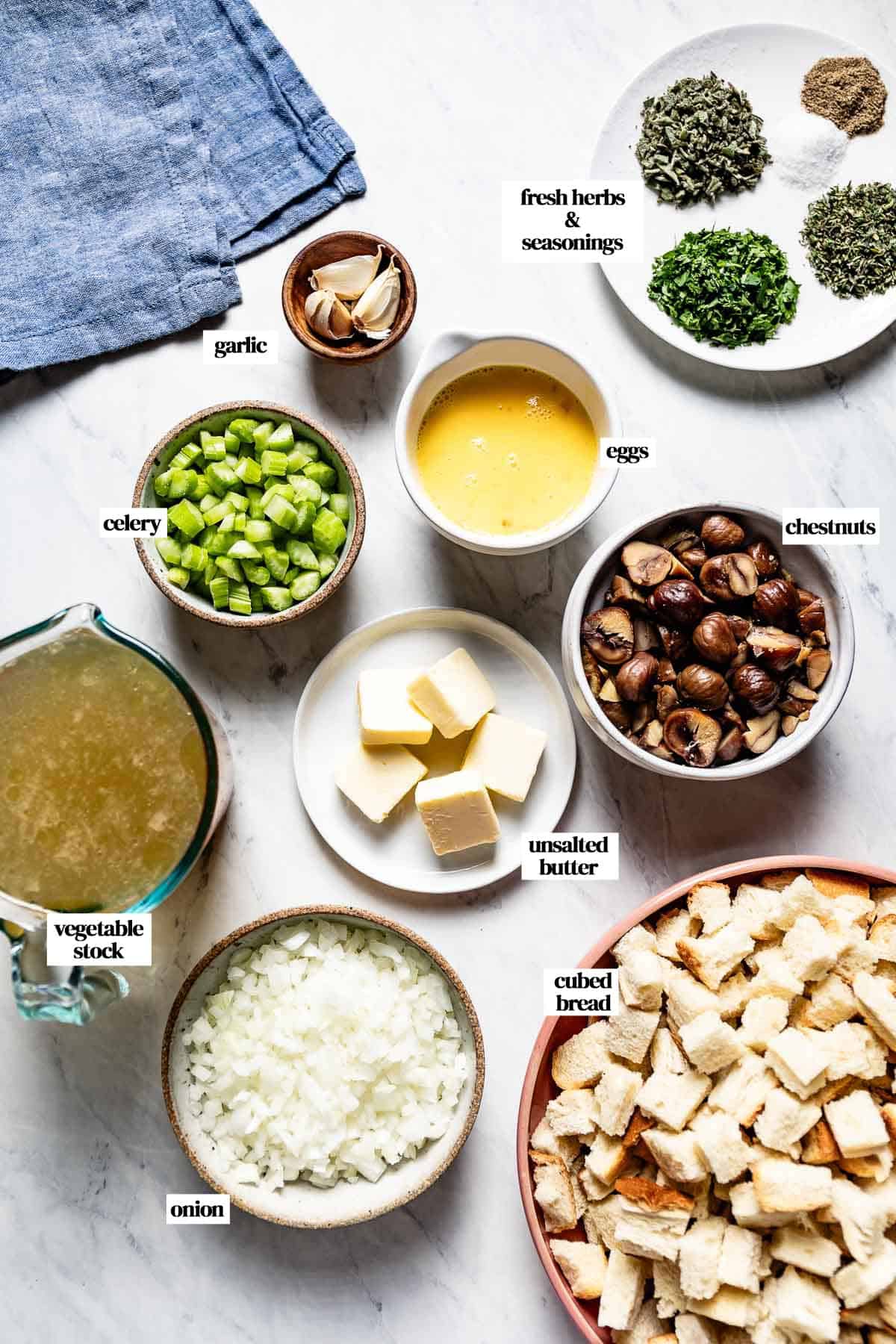
Substitutions and Optional Add-Ins
While the basic ingredients I listed above are more than enough, you can customize this chestnut dressing for turkey according to your tastebuds with a few delicious ingredients. Here are a few ways to do it:
- Meat: Pancetta, sweet Italian sausage (casings removed and crumbled), or bacon are delicious and add a meaty bite. My favorite is chestnut pancetta stuffing, but sauteed crumbled sausage is delightful as well. The key is to make sure to sautee your meat of choice before adding it to the stuffing mixture.
- Other veggies: This is where you can get creative. I like the addition of thinly sliced mushrooms or fennel.
- Heavy cream: For a richer chestnut stuffing, substitute ½ cup of the stock with heavy cream.
- A touch of sweetness: One small cubed apple or a handful of dried cranberries or raisins adds a pop of sweet flavor that would pair beautifully with the nutty flavors of this dressing recipe.
- Nuts: While it will no longer be a chestnut stuffing, you can swap chestnuts for toasted and chopped walnuts or pecans instead.
How to Make Chestnut Stuffing
Making this turkey stuffing with chestnuts couldn’t be easier. I have got you covered whether you want to bake it in a baking dish or stuff it into the turkey. Here’s how to do it:
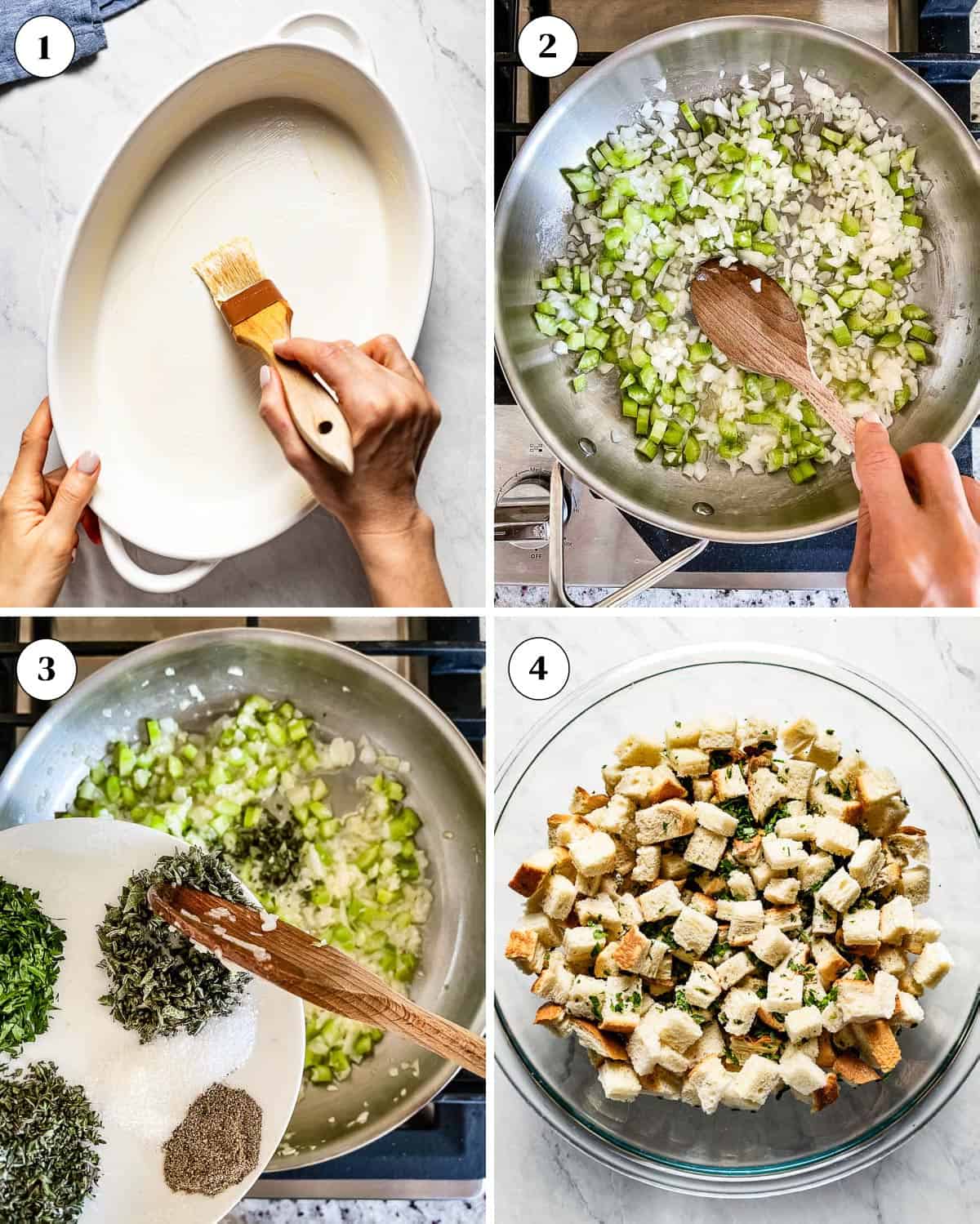
- Prep equipment: Preheat the oven to 375 degrees F. Coat a 9×13-inch shallow casserole dish with softened butter.
- Saute vegetables: In a large saute pan over medium-high heat, melt butter. Then, saute onions and celery until softened, about 5-7 minutes.
- Add aromatics: Reduce to medium heat, add the garlic, and saute for 1 minute. Add the sage and saute for an additional minute. Remove from heat and allow to cool for 5 minutes.
- Mix bread and herbs: In a large bowl, toss the cubed bread, parsley, and thyme.
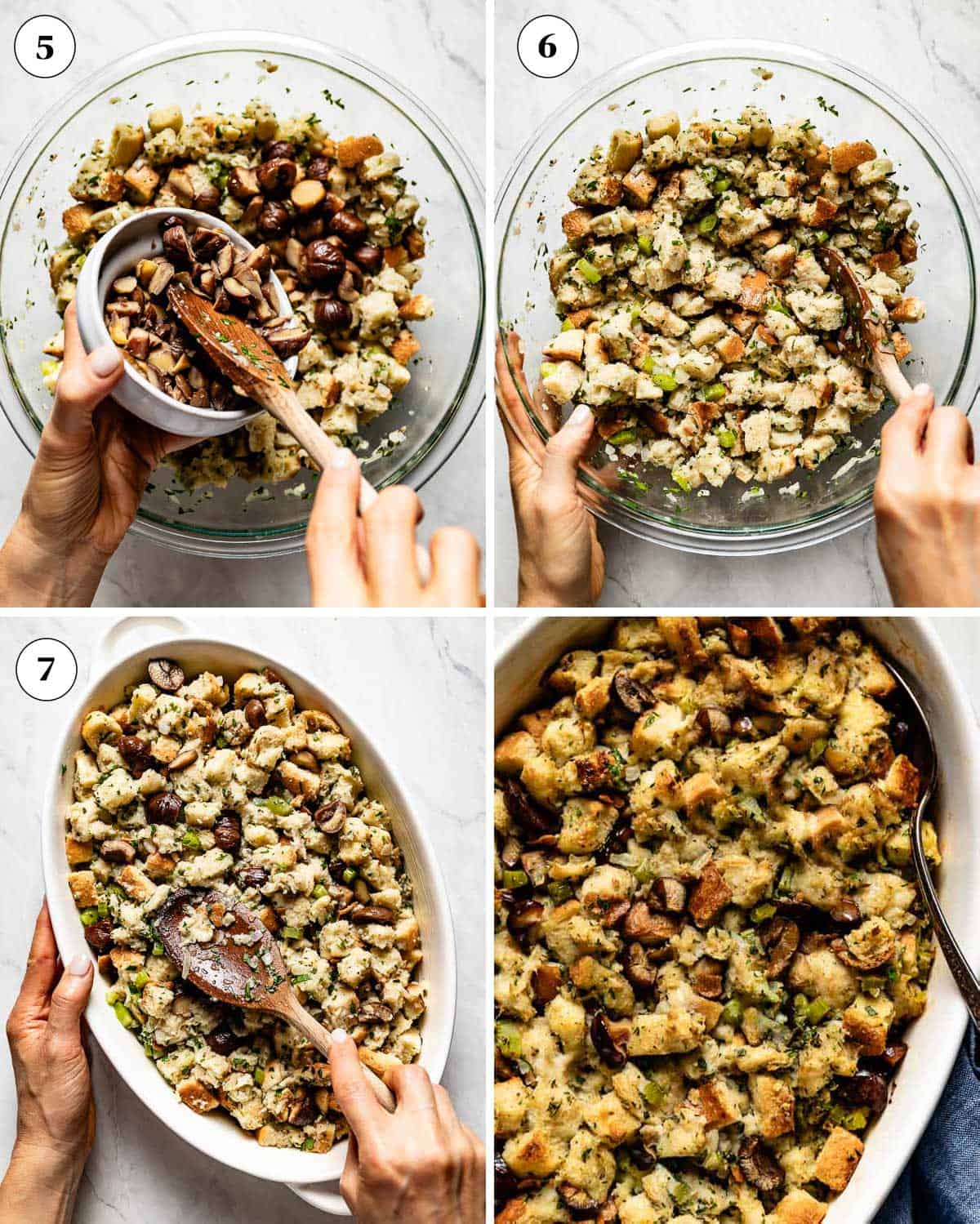
- Make stuffing mixture: Add eggs, stock, Kosher salt, pepper, and vegetable mixture to the bread mixture, gently tossing until just combined.
- Add the star ingredient: Gently stir in the chopped chestnuts.
- When it comes to cooking it, you have two options:
- Bake in a casserole dish: Transfer the mixture to the shallow baking pan and spread into a single layer. Bake, uncovered until it is golden brown on top, about 35-40 minutes. Serve warm.
- Stuff the turkey: Transfer the chestnut stuffing for turkey into the cavity of the bird until it is full and compact. Bake the turkey as needed until the internal temperature of the stuffing reaches 165 degrees F. Allow to cool, then scoop and serve alongside the carved turkey.
How to Make Ahead and Store
This old-fashioned chestnut stuffing recipe is a wonderful make-ahead dish. Here’s how I like to make it ahead, store, and reheat leftovers:
- Make Ahead: Prepare the stuffing up until baking, cover with plastic wrap, and refrigerate 1 day in advance. Remove from the fridge 30 – 45 minutes before baking to bring to room temperature. Uncover and bake as directed.
- Storage: Leftover stuffing will keep in an airtight container in the refrigerator for up to 3 days.
- Reheat: Reheat in a preheated 325-degree oven for 7 – 10 minutes, or until warmed through.
What to Serve With Chestnut Stuffing?
- Turkey: Roasted Turkey with chestnut stuffing is a quintessential recipe for your Thanksgiving table, but it’s also wonderful with classics like Cranberry Sauce and Sweet Potato Casserole. If you are celebrating a smaller Thanksgiving, serve it with Turkey Loins or Baked Turkey Wings.
- Chicken: If you prefer chicken during the holidays, pair it with Air Fried Cornish Hens, Goat Cheese Stuffed Chicken, or Whole Roasted Chicken.
- Beef: Follow along with Italy and many European countries and serve chestnuts in stuffing for Christmas dinner with Roast Beef, Pot Roast, or try my Reverse Sear Tenderloin.
Expert Tips
While this recipe is pretty straightforward and not much different than making any other stuffing, I think there are a few things to pay attention to. Here are a few helpful tips for the best chestnut stuffing recipe:
- Use day-old bread: Stale bread is best for stuffing as the dry texture absorbs all the moisture from the stock. If you only have fresh bread on hand, cut it into cubes and spread out onto a rimmed baking sheet to dry out overnight, or go for toasted bread by placing the bread cubes in a preheated 375 degrees F oven until slightly dry, about 7-10 minutes.
- Store-bought bread cubes: If you are short on time, feel free to use Pepperidge Farm stuffing cubes or those clear bags of bread cubes you find throughout the grocery store this time of year.
- Amount of liquid: We are looking for a texture that is ‘moist but not soggy’. To achieve this, the stock may have to be adjusted based on the type of bread you use. For best results, start with the 2 ½ cups in the recipe card, then add additional stock ⅛ cup at a time if you find the stuffing mix is a little dry.
- Adding meat: If you are using meat, make sure to cook it through before adding it in.
- Do not overmix: When you are mixing the chestnut turkey dressing, it is imperative that you are doing it in a gentle way. You do not want to break the bread cubes, as this will create a crumbly, mushy texture. The bread cubes will absorb the liquid and will produce a nice texture when gently tossed.
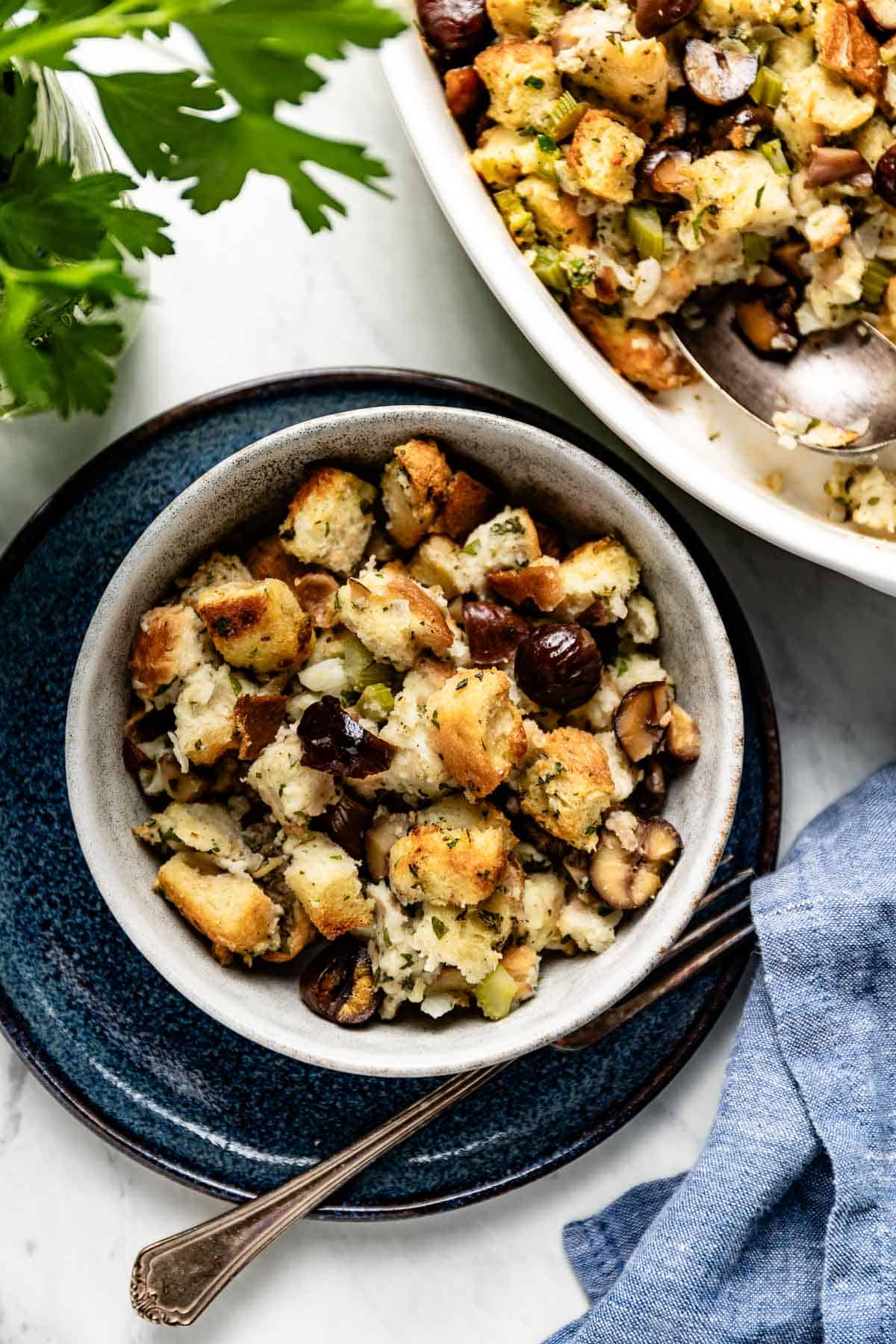
FAQs
Stuffing with chestnuts is said to have been around for more than 200 years, with the first recipe in print found in The Frugal Housewife by Susannah Carter in 1772.
This is more about personal preference. Boiled chestnuts will be soft and creamy, whereas fire-roasted or roasted chestnuts will be harder. If you make roasted chestnut stuffing, cut them into smaller pieces.
Even though you can technically freeze this dish, we do not recommend freezing as the texture will be mushy once thawed. That being said, if you would like to freeze the chestnut stuffing, do so by transferring it to a freezer-safe airtight container with room at the top for expansion. Freeze for up to 1 month. Thaw the frozen stuffing overnight in the fridge. Reheat in a 325-degree oven for 15-20 minutes, or until warmed through.
While the two terms are used interchangeably, the name you use largely depends on the region you are from and the cooking method. Technically speaking, ‘stuffing’ is cooked inside the cavity of the turkey, whereas ‘dressing’ is baked exclusively outside the turkey in a separate baking dish.
Other Stuffing Recipes You Might Also Like:
If you try this recipe for Chestnut Stuffing, please take a minute to rate the recipe and leave a comment below. It helps others who are thinking of making the recipe. And if you took some pictures, be sure to share them on Instagram using #foolproofeats so I can share them on my stories.
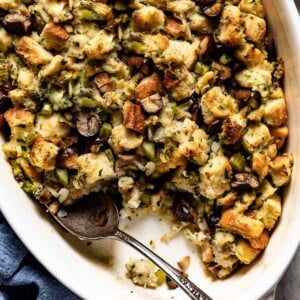
Chestnut Stuffing Recipe
Ingredients
- 4 tablespoons unsalted butter, (2 oz) plus more to coat the casserole dish
- 1 small onion, chopped
- 2 stalks celery, chopped
- 3 cloves garlic, minced
- 2 tablespoons fresh sage, chopped
- 1 pound day-old white bread , ~10 cups, cut into ½ inch cubes
- 2 tablespoons fresh parsley, chopped
- 1 tablespoon fresh thyme, chopped
- 2 large eggs, beaten
- 2 ½ cups vegetable stock, or chicken or turkey stock would also work
- 1 teaspoon Kosher salt
- 1 teaspoon ground black pepper
- 1 ½ cups cooked chestnuts*, roughly chopped
Instructions
- Preheat the oven to 375 degrees F. Coat a 9×13-inch casserole dish with softened butter.
- Melt butter in a large skillet over medium-high heat. Add the onion and celery and saute for 5-7 minutes until softened.
- Add the minced garlic and saute for an additional minute, being careful not to burn it. If necessary, reduce the heat.
- Add the chopped sage and saute for 1 minute. Take the skillet off the heat and set it aside to cool for 5 minutes.
- Place the cubed bread, parsley, and thyme in a large bowl. Toss to combine.
- Add the eggs, stock, Kosher salt, pepper, and the cooked vegetables, lightly tossing everything until just combined. Do not overmix.
- Using a spatula, gently fold in the chestnuts.
- Transfer the mixture to the prepared baking dish and spread it evenly, lightly pressing in the dish. Bake uncovered for 35-40 minutes until it is lightly browned on top. Alternatively, you can transfer the chestnut stuffing into the cavity of the bird until it is full and compact. Roast turkey as needed until the internal temperature reaches 165 degrees F. Allow to cool, then scoop and serve alongside the carved turkey.
Notes
- Yields: This recipe makes a stuffing good for 8 servings. It is enough the fill the cavity of a 14-20 pound turkey if you prefer to stuff it into your turkey. Otherwise, you can bake it in a 9X13 casserole dish. The nutritional values below are per serving.
- Stale bread: Using a day-old (or dry) bread is key to making this recipe. You can cube the bread the night before and store it uncovered to dry it out. Or, you can bake the cubes on a baking sheet in a 375-degree F oven for 10 to 12 minutes without browning. However, make sure that they are fully cooled before using them in this chestnut stuffing recipe.
- Chestnuts: You can purchase already-cooked chestnuts from the store. Just make sure that the only ingredient in the packaging is chestnuts. Alternatively, you can buy raw chestnuts and cook them yourself. I highly recommend buying Italian chestnuts (instead of Chinese) as they are easier to peel. You can boil chestnuts, roast them in the oven, or even roast them in an open fire following our recipes.
- Moisture: If you feel the chestnut dressing appears dry, you can add more stock in ⅛ cup increments to your preferred moisture. Remember that the stock will evaporate slightly during the cooking. It is best not to make this stuffing too moist.
- Make Ahead: Prepare the dressing up until baking, cover with plastic wrap, and refrigerate 1 day in advance. Remove from the fridge 30 – 45 minutes before baking to bring to room temperature. Uncover and bake as directed.
- Storage: Leftover stuffing will keep in an airtight container in the refrigerator for up to 3 days. Just make sure to bring it to room temperature before storing it.
- Reheat: Reheat in a preheated 325-degree oven for 7 – 10 minutes or until warmed through.
- Covering the top: During our recipe testing, we did not feel the need to cover this dressing with foil while it was baking in the oven. However, if yours is browning too quickly (especially if you are cooking multiple things in your oven), you can cover it with aluminum foil until the baking is nearly complete. Then, uncover the dish for the last 5-10 minutes to ensure it is fully cooked.
Nutrition
Nutrition information is automatically calculated, so should only be used as an approximation.
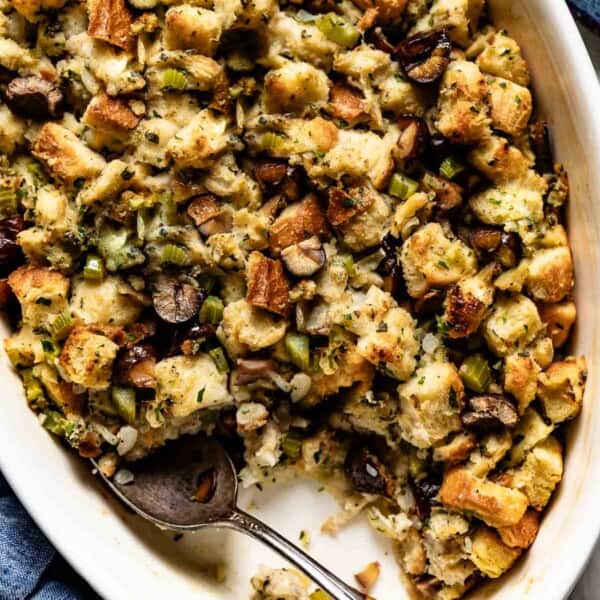
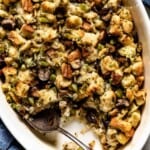
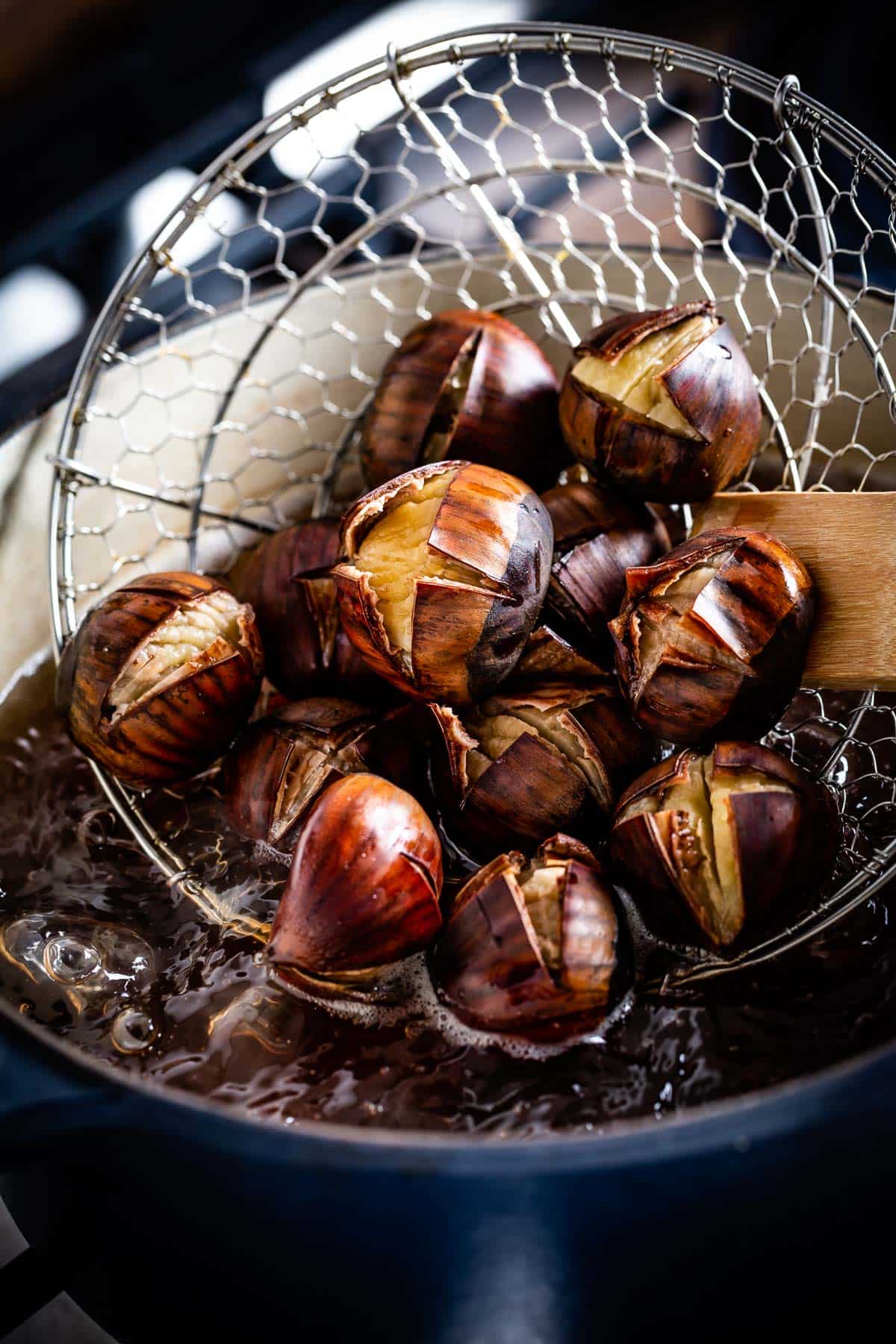
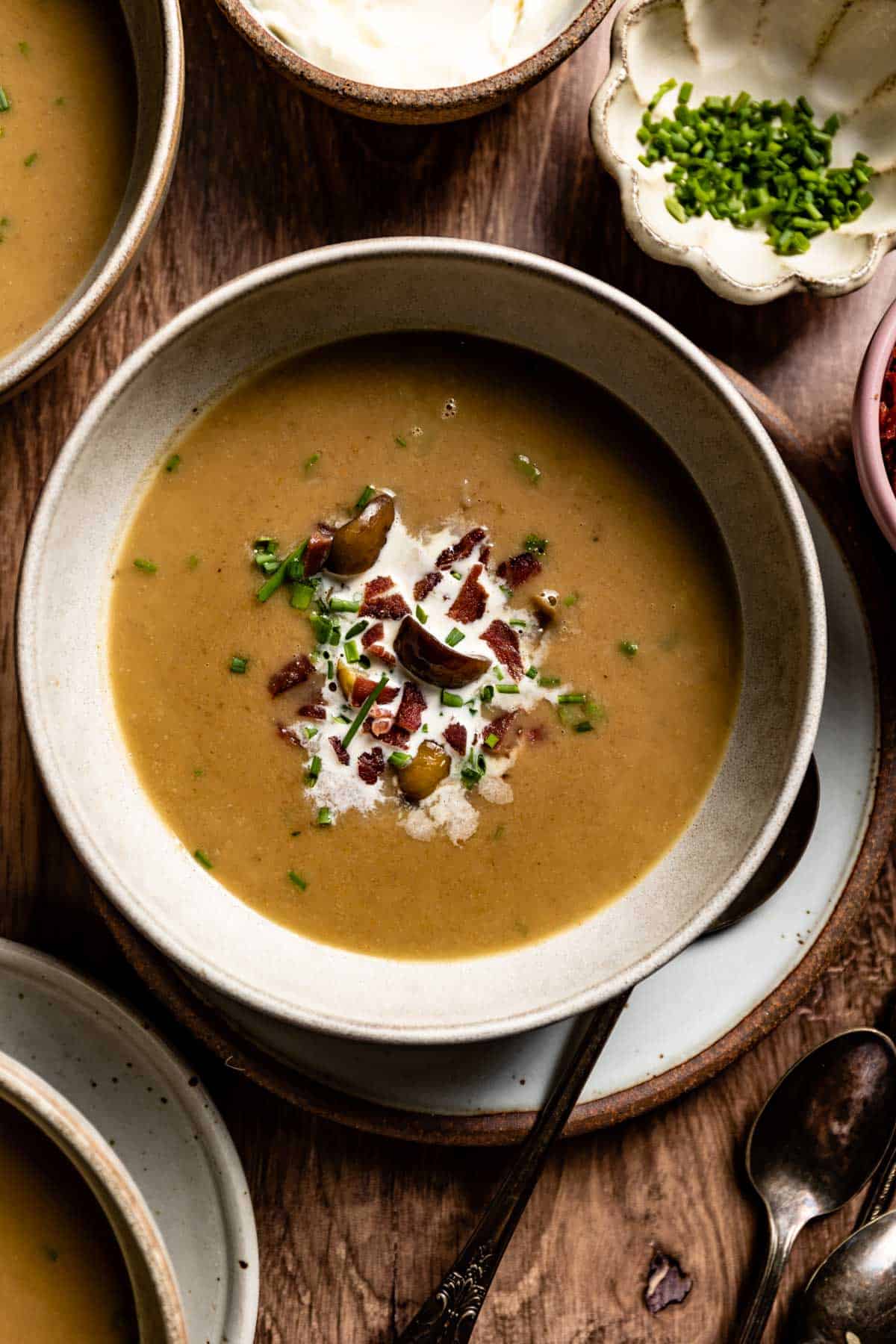
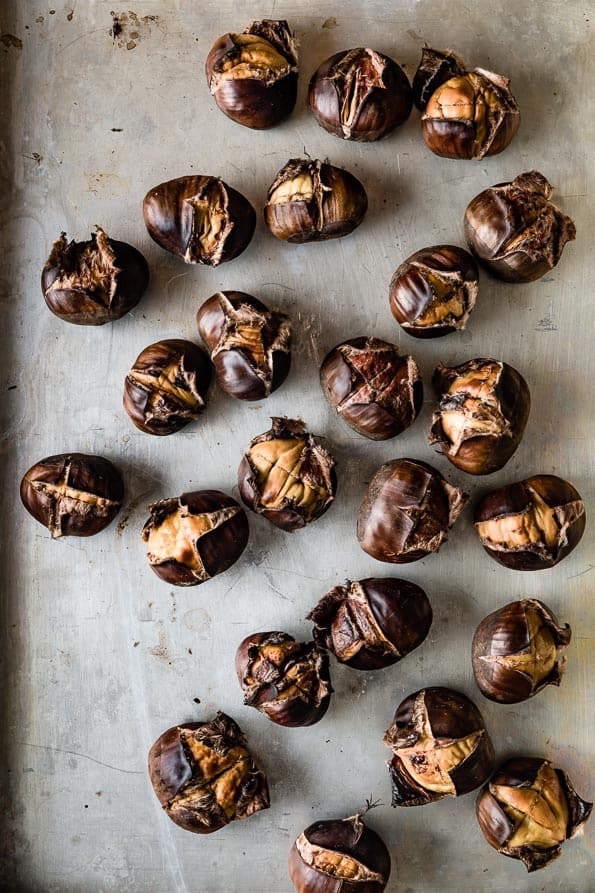
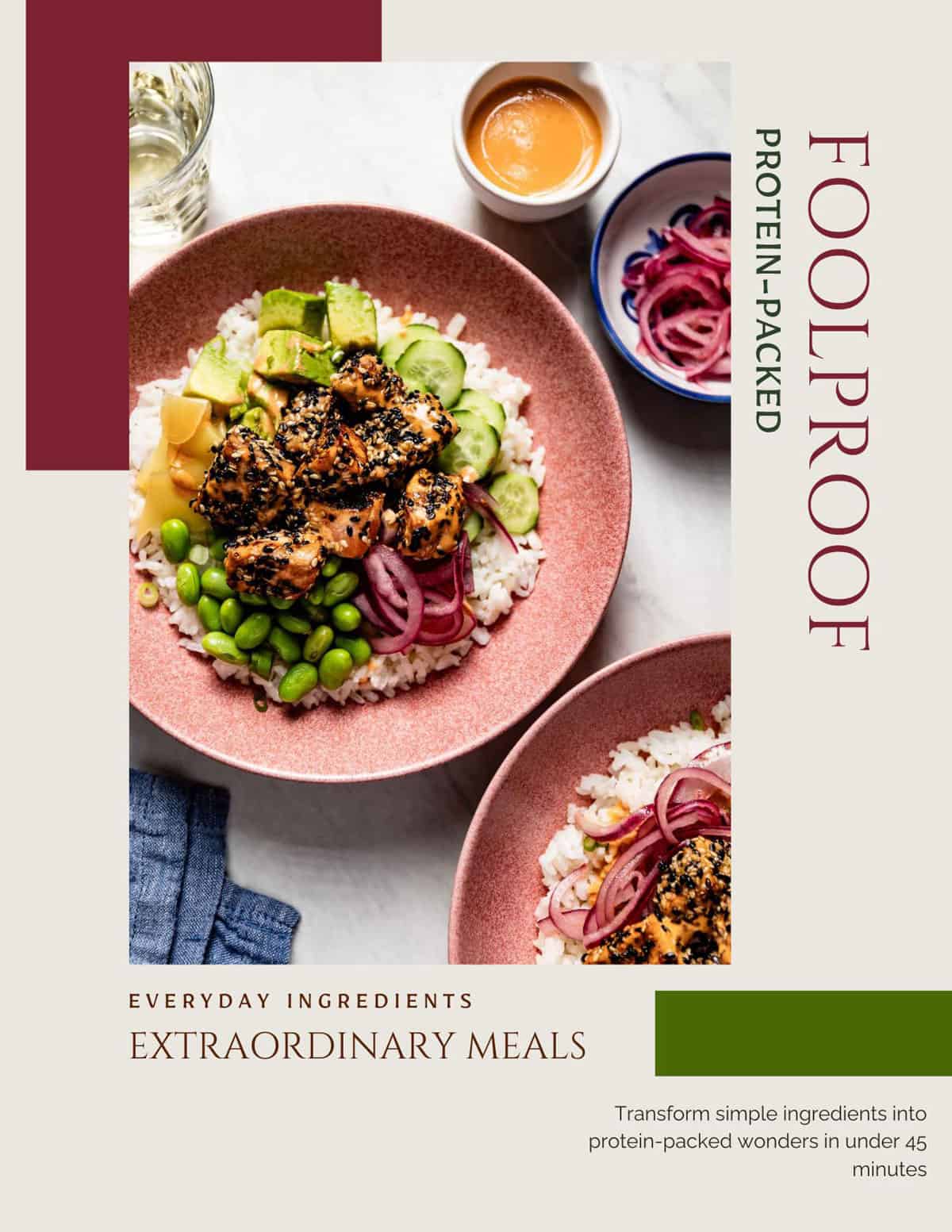









Made this for the first time yesterday and took to a pot luck Christmas Dinner… It was a hit! I kept to the original recipe but will try with bacon or pancetta next time. Thanks!
YAY! So happy to hear that you liked it Donnie.
I agree, the addition of bacon or pancetta would be lovely.
Thanks for coming by, sharing your experience and taking the time to leave a review.